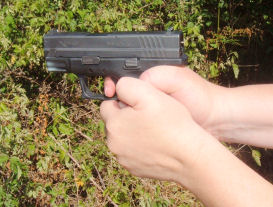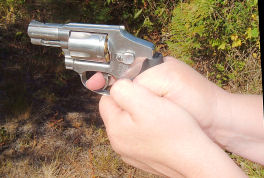A good firing grip is important for several reasons.
First and foremost, a good grip means that you are holding the gun in the safest possible manner. It’s important to put your hands in the right places on the handgun so that you are not damaged by the slide activity of a semi-automatic, or by the hot gases coming out of the cylinder area of a revolver. It’s also important to hold the gun firmly so that it does not twist in your hand, causing unexpected strain to your hands or wrists.
A good grip helps you shoot accurately, while a poor one can prevent accuracy even if you are doing everything else right.
If you are firing a semi-automatic handgun, a good, solid grip allows the firearm to function at its best. Because semi-automatic parts move while firing, the pistol’s best reliability depends upon having a solid, nearly immobile platform for it to work from. You provide that platform with your solid grip and stance.
The exact definition of “good grip” will vary according to the shooting discipline you participate in. A good self-defense grip is extremely strong and very secure, so that if an attacker is very close he will be unable to wrest the handgun away from you while you are firing. This grip must allow you to shoot quickly and to rapidly re-align your sights after shooting. It must enable you to fire at moving targets, possibly while you are also moving. And it must be flexible enough to allow you to do all of these things without stopping or readjusting your hands in any way in between shots.
In contrast to this, a good target shooting grip needs only to hold the firearm securely enough for safety and reliable function, so that the shooter may shoot as accurately as possible. Neither intensive speed nor extreme security are needed for target shooting. In fact, a too-firm grip is one thing that can prevent really precise accuracy. While target shooting, you’ll have enough time to readjust your grip and your stance between shots, although you may not want to do this since consistent accuracy really requires doing the same thing the same way every time.
The photos below illustrate some do’s and don’t’s of grips appropriate to self defense shooting. If you are interested only in target shooting, especially in any of the high-accuracy, high-concentration distant target shooting sports, you will be better served looking elsewhere for information about how to hold the firearm.
 A good, solid grip
|
The photo above shows one good, solid grip. Note that both wrists are straight rather than bent, allowing the gun’s recoil to be absorbed by the bones rather than by muscles or tendons. The thumbs are locked downward, one over the other, which is the natural way a human hand makes a fist to hold stuff most securely. The shooter uses the crease of her finger, rather than the pad, to pull the trigger, because doing so gives her finger an additional measure of strength so that it will be able to fire quickly and repeatedly if needed.
Both hands provide equal tension in holding the firearm securely, and the muscles are quite tense rather than relaxed while firing. This mimics the muscle tension one may expect to experience when using the gun for self defense during a stress-filled encounter.[ref]This is very different from a target shooter’s grip even though it may look similar to a casual observer. Most target shooters will relax the shooting hand almost entirely, allowing the non-shooting hand to do most of the work of holding the gun. Their muscles will be relaxed rather than tense while firing; this allows greater precision, but sacrifices security.[/ref]
 A thumbs locked down grip
|
The grip in the photo above is the same as the one in the first photo, but this time the shooter is holding a revolver. The fingers of her left hand are all touching each other, and her left index finger is jammed right up underneath the trigger guard. She is using the “power crease” of her trigger finger to fire the gun, an especially important point while firing rapidly in double action. Her wrists are straight, so that the energy from the fired shot will be cushioned by her arm bones and will not wrench her wrists.
 A good, solid grip
|
In the photo above, the shooter is resting one thumb on top of the pistol’s thumb safety. This is beneficial for several reasons. Doing so enables her to flick the safety off very quickly as she raises the gun to fire. It also guarantees that the safety cannot be bumped on unintentionally while she is firing.
Note that the shooter’s wrists are still straight, and that her hands are still clenched firmly enough that she has a very solid grip on the gun. Although the thumbs-forward grip does not allow quite as much security as a thumbs-locked-down grip, it is nearly as secure and can be very beneficial to the shooter whose firearm is equipped with a thumb safety.
 A not-so-secure way to hold the gun, the teacup grip is not recommended |
Above is an example of an insecure hold, the teacup grip (sometimes called the cup-and-saucer grip). From a defense shooter’s perspective, the chief problem with this hold is that the non-dominant hand provides no assistance in recoil control for rapid shots, and little assistance in retaining the gun if necessary.
The sole advantage of the teacup grip is that the non-dominant hand does give additional support to the lifting muscles in the dominant arm. This means that if you ever need to hold someone at gunpoint for an extended period of time, you may want to bring your arms closer to your body, relax your elbows slightly, and allow your hands to fall into the teacup grip. Just remember it isn’t best for shooting or for hanging onto the gun if you are in a fight for your life.
 What’s that finger
|
Above is another grip I don’t recommend. Placing the non-shooting trigger finger forward accomplishes nothing at all: neither recoil control, nor strength, nor accuracy are improved by it. In fact, putting that finger forward lessens the gripping strength of your non-shooting hand, which in turn weakens your entire grip.
 A wrist brace? |
Sometimes you will see an old-time revolver shooter using the wrist-brace grip. It really isn’t necessary to reinforce the wrist in this fashion, and doing so prevents your non-shooting hand from doing other good stuff like helping to hold the gun securely.[ref]If your wrists hurt while shooting, there’s a good chance that you are not holding them straight but are instead crooking them while firing. The solution isn’t to put your other hand up to hold your crooked wrist still. Instead, learn to learn to fire with your wrist straight.[/ref]
More important: getting into the habit of holding a firearm in this way can be very dangerous. If you try it with a semi-automatic, either deliberately or out of thoughtless habit, you’ll painfully discover why it’s such a bad idea (see next entry.)
 Do not allow the thumb to rest behind the slide! |
It is important never to allow your thumb to rest behind the slide of a semi-automatic. When a shot is fired, the slide moves very quickly toward the rear, and then is driven forward again by a powerful spring. If your thumb is in the way of this movement, injury is very likely.
After you become more proficient with the gun, you might try to fire with your non-dominant hand sometimes. If you do so, please remember that your dominant hand thumb is likely to slip behind the slide out of habit when you are not paying attention. Don’t let this happen — it hurts!



